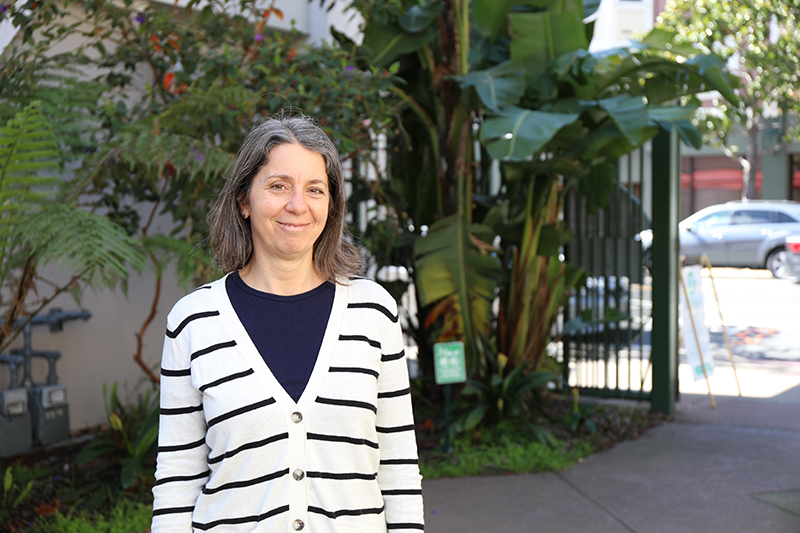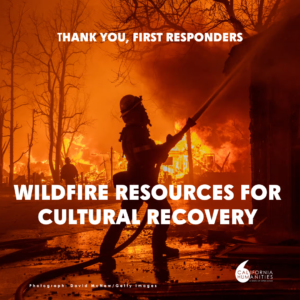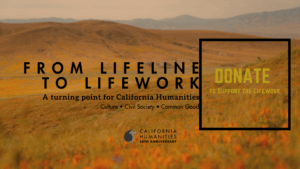Debbie Kahn is a librarian and archivist working for California Humanities. After our 40th anniversary celebration, we hired her to look through our records and documents and see what might be historically significant, and what could be let go. In the course of this work she’s inventoried and organized the historical paperwork, digital files, and media associated with past grants. With the recent craze of personal organization making its way into our homes via Marie Kondo’s famous Netflix show “The Life Changing Magic of Tidying Up,” we realized, after a recent staff meeting where Kahn presented her work and tips of the trade with our staff, that we wanted to learn more. She wrote the below guest post about how she applies her professional training—and sometimes doesn’t—to her work as an archivist, and to her own personal organization in her home. Read about her approach, which we’re calling the “KahnDebbie Method,” and get some of her tips for how to use these skills in your own life to stay organized for the long run.
When I tell people what I do for a living, some assume that I’m a very organized person at home. That’s partially true. In addition to my work at California Humanities, I also work at a local museum as a cataloger. I became an archivist later in life—I worked in tech for a while, but when the bubble burst in 2001 I went back to school to study history and eventually worked for a Holocaust education and research organization. The librarian and archivist there opened my eyes to the profession. I then got a Master of Library and Information Sciences degree—a perfect blend of my interests in history and technology.
My experience with library, archives and museum professionals indicates that there is a range of levels of organization in this group. Some of us live with piles of books on the floor, while others alphabetize the condiments in their refrigerators. I’m somewhere in the middle of this range. At home, I have areas that are very organized, such as books, vital records, kitchen tools. Others are less so.
I’ve watched three episodes of Marie Kondo’s show so far. It’s clear that her approach has a lot of appeal for people. Honestly, watching the show made me reevaluate and reorganize some of the corners and drawers in my own home. From an archivist’s perspective, I can see both the benefits and drawbacks of her approach. I like her way of dividing one’s possessions into five main categories: clothing, books, papers, komono (miscellaneous), and mementos. I think that komono needs to be broken down further, but the overall approach a good start.
The truth is I’m more organized at work than I am at home, mainly because my work centers on ensuring that the material there are well-documented and available for research. At work, no one will be able to connect with any materials that I don’t catalog. This isn’t true at home. However, we still need to be able to find and use the items we own. In general, my philosophy at home is to organize where necessary.
On records: They don’t spark joy, but you should keep them anyway
I think of organization in two different ways: the day-to-day, and the long-term collection or personal archive. Day-to-day organization simply means that things in the home are stored out of the workspace. Clutter can be stressful. It’s challenging to think about cooking a meal with messy counters, and it can be difficult to pay bills at a desk full of random papers.
Marie Kondo’s “spark joy” mantra encourages people to declutter their homes in a way that seems less like a chore. Reducing one’s possessions can bring into focus the items (clothing, photographs, decorations) that make you happy. However, this doesn’t work for some categories of items. Do my three-year-old tax returns spark joy? Certainly not, but they still need to be stored. I would add an axis of “Is it useful?” Maybe my rice cooker doesn’t spark joy, but it is very useful.
Day-to-day organization involves paperwork, legal documents, and records. A record is any evidence of a transaction of some kind and may carry some kind of legal obligation: leases, deeds, tax returns, invoices, birth certificates, financial records. These documents should be kept in a safe place for a certain amount of time. Not everything requires permanent retention, and this Consumer Reports article provides a good framework for determining how long and how to store personal records.
Saving information to create a personal archive
Creating a personal archive is different from keeping day-to-day records. In a sense, it is about shaping the story of your life for people in the future. This can include records, but records don’t tell the entire story. For example, personal correspondence, like a letter, is not necessarily a record, but can provide real information about the writer. Photographs can be records— documenting the results of a fender bender, or a new home—but also provide details about a person’s life. Records show the legal touchpoints of a person’s life, but other documents provide a richer view.
When deciding what to keep or discard for your personal archives, think about keeping only the documents that tell the story of your life. A set of photographs, labeled even minimally (for example, “Family vacation 2010” with the names of the participants) can say a lot about how a person lived and interacted with others. A receipt for or photograph of something that is important to you, like an heirloom cookie jar, has more meaning that the receipt for some car repairs in 2005.
More progress, less process
Looking at a large undifferentiated mass of documents, the thought of handling each individual piece of paper, photograph, email, and digital file can be daunting. Instead, archivists who frequently receive multiple, dozens, or even hundreds of boxes of materials follow a philosophy of “More progress, less process” (MPLP). Mark A. Greene and Dennis Meissner developed this idea to remedy the backlogs in some archives due to existing processing methods. Previously, archivists cataloged each individual document. In most cases, MPLP practitioners let go of item-level cataloging where possible in favor of describing collections at a minimal level needed for access: general description of the collection, arrangement by series, folder-level and series-level descriptions, and minimal preservation necessary.
This philosophy is useful when approaching the creation of a personal archive. Rather than looking at each item and making a decision at that level, try to group things into categories that make sense to you (i.e. legal papers, correspondence, photographs, other people’s personal papers, or maybe a chronological arrangement). Chances are that some of the items are already categorized into folders, or sections on a shelf, or a box. Don’t look through each folder or album of photographs– just put them in the photograph section. Once you create these large categories, you can go through and organize them at a more detailed level. This is somewhat similar to the KonMari method. More detailed information about this process can be found in these articles from the Library of Congress and the Smithsonian.
Remember—perfect is the enemy of good. You do not need to organize everything perfectly to make it useful as a personal archive. People will appreciate even a minimal level of organization and context for your documents.
But how to store all of these items? In one episode of the Netflix show, I watched a couple place their photographs in a photo album with adhesive pages. Marie Kondo didn’t seem to tell them to use this, but I gasped when I saw it. Adhesive is not suitable for permanent storage of photographs, as it will eventually damage them.
To make sure your materials are safer for the long-term, here are some general tips for paper and document storage:
- I tend to keep the important papers in acid-free folders, but normal manila folders are acceptable.
- Avoid storing papers in the long-term in hanging folders, as these are acidic and will eventually damage papers in contact with them.
- For photographs, get an archival photo album with either acid-free pages or plastic pockets (or both), or get archival boxes and sleeves specifically designed for photographs.
Some kinds of paper are more vulnerable to damage over time—newsprint and construction paper will become brittle and discolored over time, while thermal fax paper will fade and become unreadable. As long as it’s under control, paper is actually a fine way to store information. It doesn’t require any hardware (disc drive) or software (word processing) to read, you can drop it on the ground and still use it, and it can generally survive getting wet. Paper doesn’t need any upgrades, and you can still read paper from the 1980s, unlike the WordStar and PageMaker 1.2 files from that era.
To digitize or not to digitize
If the amount of paper is overwhelming, though, one way to reduce or preserve access to paperwork is to scan it. Scanned documents, as long as they accurately reproduce the original and are stored in a non-rewritable and non-erasable format, such as a read-only disc, are admissible in a legal setting. It’s safe to scan materials and discard the original, as long as the scans are kept safe.
Do not discard the paper copies of critical documents (birth certificates, deeds, etc.). In this case, the scan would be more of a backup. For example, the US passport office will not accept a scan of a birth certificate.
Once the documents are scanned, they should be organized into a system that makes sense. Use a file naming system that describes the document: “RentalAgreement_2015” rather than “scan1188348”. Put the files into folders that give some structure to the overall collection, e.g. “Taxes,” “Medical” and “Household”.
Scanned documents are vulnerable to all of the dangers of any computer file. This applies to scanned and digital photographs as well. File format obsolescence – when certain computer programs go out of date – which I alluded to above, is a major issue with archives. In addition, the ones and zeroes that make up all files at a basic level can sometimes change from one to the other (this is called “bitrot”), rendering a file partially or completely unreadable. Passwords to encrypted files can be lost, causing the files to become indecipherable (literally).
It’s a good idea to have backups of all files. The archival principle of LOCKSS, or “Lots Of Copies Keeps Stuff Safe”, applies here. LOCKSS stipulates that if one digital file fails, it’s likely that another copy kept elsewhere will still be readable and can replace the broken one. Keep at least two copies. Three or four is better. External hard drives, DVDs and the cloud are all options, but it’s not a good idea to store everything in the cloud—it’s better to have at least one copy of a file on a medium that you own.
Making your archive usable to those who come after
In the memory institutions I’ve worked in, we’ve received a lot of donations from people who are either donating their own materials or are heirs trying to decide what to do with an inherited collection. Sometimes it’s photographs, or career history documents or rare books. If you are donating your own materials, some quick research on the web can point you in the direction of an appropriate institution. For people in California or state-based collections, the Online Archive of California lists collections in most of the memory institutions in the state and can provide guidance for those who might be interested in donations.
If you want to donate your documents or materials to an institution at some point, the people working there will greatly appreciate a more organized set of files and will be able to make them available to the public more quickly. There is a great video from two archivists about how they process new collections, from the well-organized to the ones that arrive in trashcans and bags. This gives a sense of how archival work proceeds if you are thinking about donating.
Not everything can be preserved in an institution. The vast majority of personal archives will eventually go to a person’s heirs, who will also appreciate a curated and organized collection.
—
An organized and well-documented life requires some maintenance. Day-to-day items should be accessible. Clutter should be kept to a minimum. Paperwork should be periodically reviewed, scanned, organized, and/or discarded if necessary. The personal archive should be regularly maintained. Once the initial steps have been taken, the maintenance takes very little time, maybe part of a day or two every few months. The KonMari method is a great start and can give some structure to the lifelong project of an organized home.






